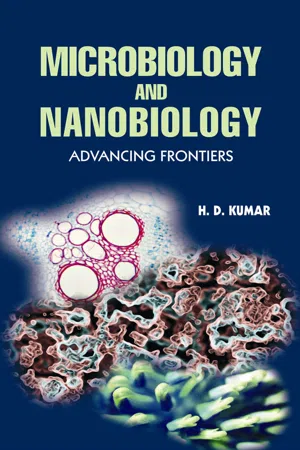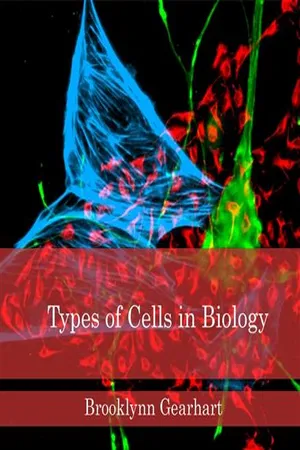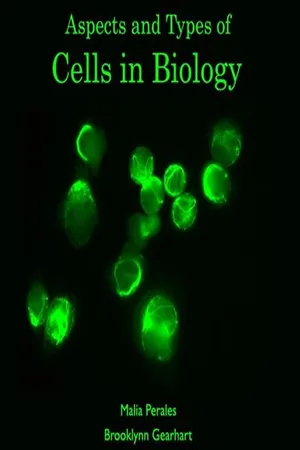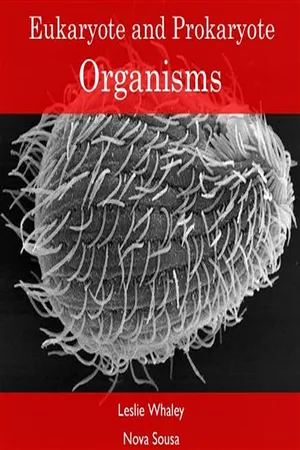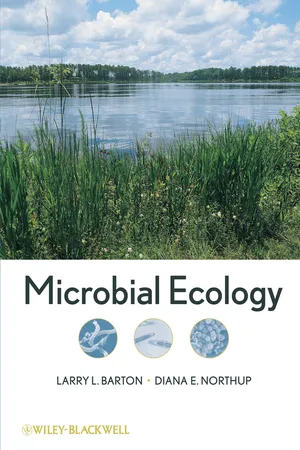Biological Sciences
Archaea Examples
Archaea are a group of single-celled microorganisms that are distinct from bacteria and eukaryotes. Examples of archaea include extremophiles such as thermophiles, which thrive in high-temperature environments, and halophiles, which live in high-salt conditions. Methanogens, which produce methane as a metabolic byproduct, are another example of archaea. These organisms play important roles in various ecosystems and biogeochemical processes.
Written by Perlego with AI-assistance
10 Key excerpts on "Archaea Examples"
- Kumar, Har Darshan(Authors)
- 2021(Publication Date)
- Daya Publishing House(Publisher)
Chapter 4 The Archaea and Extremophilic Microorganisms The discovery of the Archaea was a milestone that challenged the paradigm that life splits neatly into two distinct groups, one prokaryotic and the other eukaryotic. There are in fact three primary lineages (or domains) of evolutionary descent: Bacteria, Eukarya, and Archaea (see Friend, 2007). The Archaea constitute one of the two groups of prokaryotes, the other being bacteria. Archaea are distinguished from bacteria by numerous genetic and physiological differences. Those members of the archaea that have been cultivated in the lab produce methane or are tolerant of unusually high temperatures or salinities. Uncultivated archaea, such as those now known to be abundant in the deep sea, may have other distinctive functionalities. Some archaea fix nitrogen. Evolutionary studies place the archaea, bacteria and eukaryotes as three fundamentally different domains of life. It was the methanogens that provided the first evidence that there was more to life than bacteria and eukaryotes. Karl Stetter has been a hunter extraordinaire of microbes that live in boiling, sulfide-rich waters. Norman Pace combined molecular phylogenetics with strategies to extract DNA sequences directly from natural communities of microbes. He explored the microbial world without requiring that the organisms of interest be grown in cultures, ushering in a revolution in microbial ecology. Friend himself visited Costa Rican rainforests to collect termites that house a microbial community in their gut; this community may be the This ebook is exclusively for this university only. Cannot be resold/distributed. world’s bioreactor par excellence for degrading cellulose. Many different biotechnological applications stem from these and other exotic Archaea, including the potentials to minimize our reliance on fossil fuels and to remediate some rather nasty chemical dumps.- No longer available |Learn more
- (Author)
- 2014(Publication Date)
- Research World(Publisher)
Archaea are now recognized as a major part of Earth's life and may play roles in both the carbon cycle and the nitrogen cycle. No clear examples of archaeal pathogens or parasites are known, but they are often mutualists or commensals. One example is the methanogens that inhabit the gut of humans and ruminants, where their vast numbers aid digestion. Methanogens are used in biogas production and sewage treatment, and enzymes from extremophile archaea that can endure high temperatures and organic solvents are exploited in biotechnology. Classification New domain For much of the 20th century, prokaryotes were regarded as a single group of organisms and classified based on their biochemistry, morphology and metabolism. For example, microbiologists tried to classify microorganisms based on the structures of their cell walls, their shapes, and the substances they consume. However, a new approach was proposed in 1965, using the sequences of the gene s in these organisms to work out which prokaryotes are genuinely related to each other. This approach, known as phylogenetics, is the main method used today. Archaea were first found in extreme environments, such as volcanic hot springs. Archaea were first classified as a separate group of prokaryotes in 1977 by Carl Woese and George E. Fox in phylogenetic trees based on the sequences of ribosomal RNA ________________________ WORLD TECHNOLOGIES ________________________ (rRNA) genes. These two groups were originally named the Archaebacteria and Eub -acteria and treated as kingdoms or subkingdoms, which Woese and Fox termed Urkingdoms . Woese argued that this group of prokaryotes is a fundamentally different sort of life. To emphasize this difference, these two domains were later renamed Archaea and Bacteria. The word archaea comes from the Ancient Greek ἀ ρχα ῖ α, meaning ancient things. - No longer available |Learn more
- (Author)
- 2014(Publication Date)
- College Publishing House(Publisher)
Archaea are now recognized as a major part of Earth's life and may play roles in both the carbon cycle and the nitrogen cycle. No clear examples of archaeal pathogens or parasites are known, but they are often mutualists or commensals. One example is the methanogens that inhabit the gut of humans and ruminants, where their vast numbers aid digestion. Methanogens are used in biogas production and sewage treatment, and enzymes from extremophile archaea that can endure high temperatures and organic solvents are exploited in biotechnology. Classification New domain For much of the 20th century, prokaryotes were regarded as a single group of organisms and classified based on their biochemistry, morphology and metabolism. For example, microbiologists tried to classify microorganisms based on the structures of their cell walls, their shapes, and the substances they consume. However, a new approach was proposed in 1965, using the sequences of the genes in these organisms to work out which prokaryotes are genuinely related to each other. This approach, known as phylogenetics, is the main method used today. Archaea were first found in extreme environments, such as volcanic hot springs Archaea were first classified as a separate group of prokaryotes in 1977 by Carl Woese and George E. Fox in phylogenetic trees based on the sequences of ribosomal RNA ________________________ WORLD TECHNOLOGIES ________________________ (rRNA) genes. These two groups were originally named the Archaebacteria and Eub-acteria and treated as kingdoms or subkingdoms, which Woese and Fox termed Urkingdoms . Woese argued that this group of prokaryotes is a fundamentally different sort of life. To emphasize this difference, these two domains were later renamed Archaea and Bacteria. The word archaea comes from the Ancient Greek ἀ ρχα ῖ α, meaning ancient things. - No longer available |Learn more
- (Author)
- 2014(Publication Date)
- Academic Studio(Publisher)
Archaea are now recognized as a major part of Earth's life and may play roles in both the carbon cycle and the nitrogen cycle. No clear examples of archaeal pathogens or parasites are known, but they are often mutualists or commensals. One example is the methanogens that inhabit the gut of humans and ruminants, where their vast numbers aid digestion. Methanogens are used in biogas production and sewage treatment, and enzymes from extremophile archaea that can endure high temperatures and organic solvents are exploited in biotechnology. Classification New domain For much of the 20th century, prokaryotes were regarded as a single group of organisms and classified based on their biochemistry, morphology and metabolism. For example, microbiologists tried to classify microorganisms based on the structures of their cell walls, their shapes, and the substances they consume. However, a new approach was proposed in 1965, using the sequences of the genes in these organisms to work out which prokaryotes are genuinely related to each other. This approach, known as phylogenetics, is the main method used today. ________________________ WORLD TECHNOLOGIES ________________________ Archaea were first found in extreme environments, such as volcanic hot springs. Archaea were first classified as a separate group of prokaryotes in 1977 by Carl Woese and George E. Fox in p hylogenetic trees based on the sequences of ribosomal RNA (rRNA) genes. These two groups were originally named the Archaebacteria and Eubacteria and treated as kingdoms or subkingdoms, which Woese and Fox termed Urkingdoms . Woese argued that this group of prokaryotes is a fundamentally different sort of life. To emphasize this difference, these two domains were later renamed Archaea and Bacteria. The word archaea comes from the Ancient Greek ἀ ρχα ῖ α, meaning ancient things. - eBook - ePub
- Dave Wessner, Christine Dupont, Trevor Charles, Josh Neufeld(Authors)
- 2016(Publication Date)
- Wiley(Publisher)
Like the bacteria that we examined in Chapter 2, archaea lack a true nucleus. These organisms, however, differ in fundamental ways from both bacteria and eukarya. Although we still know relatively little about archaea, our studies of these microorganisms have shed light on important aspects of how proteins and cells function and future studies promise to provide insight into the evolution of all living organisms. The story of the domain Archaea is both exciting and exotic; it begins in some of the most inhospitable environments on Earth. Since the discovery of the first organisms that grow optimally in environments with extreme chemical and/or physical properties, microbiologists have searched for signs of life in almost every imaginable environment on Earth. Perhaps surprisingly, or perhaps not, we have found living organisms that thrive in every explored environment. From the boiling waters of hot springs to the frigid environments of Antarctica, and from the low-pH, sulfur-rich waters often associated with volcanoes to the high-pH waters of lakes containing sodium carbonate, life, it seems, exists everywhere. Underwater, hydrothermal vents are no exception. Often referred to as black smokers, these vents actually represent fissures in Earth’s crust through which geothermally super-heated water escapes. Often topping 400°C initially, this mineral-laden water cools quickly, causing the precipitation of its mineral contents and the gradual formation of the characteristic rock chimneys. Studies of black smokers in oceans throughout the world have demonstrated that a wonderful array of life calls these very hot environments home (Figure 4.1), including many archaea. We should note, however, that archaea are not relegated solely to these seemingly harsh environments. Current studies show that archaea inhabit myriad environments that we may consider to be more hospitable, such as soils, freshwater, marine water, and even the human body - eBook - ePub
- Larry L. Barton, Diana E. Northup(Authors)
- 2011(Publication Date)
- Wiley-Blackwell(Publisher)
Epulopiscium's extreme polyploidy may support the occurrence of the unstable long mononucleotide tract without harm to the cell. Polyploidy is not unknown in bacteria, but has never been observed before on this scale. Investigation of the evolutionary significance of this phenomenon promises new insights.2.5 Discovery of Archaea as a Separate DomainWhat are the roots of the discovery of the Archaea ? Woese and Fox (1977) stated:The biologist has customarily structured his world in terms of certain basic dichotomies. Classically, what was not plant was animal. The discovery that bacteria, which initially had been considered plants, resembled both plants and animals less than plants and animals resembled one another led to a reformulation of the issue in terms of a yet more basic dichotomy, that of eukaryote versus prokaryote.Thus began their paper that identified three major lines of descent that encompassed all living organisms, which included the separate division that they proposed to call the archaebacteria, which we now term the Archaea : “There exists a third kingdom which, to date, is represented solely by the methanogenic bacteria….These ‘bacteria’ appear to be no more related to typical bacteria than they are to eukaryotic cytoplasms.”It's fascinating to look back in time over the shoulders of the scientists who described the methanogens as a separate domain of life and forever changed our view of the living world. Woese and Fox (1977) went on to predict that additional domains would not be discovered. To date, their prediction has been borne out. Although known at the time, the halophiles were not included in the newly suggested archaebacterial domain.2.6 Archaeal DiversityDuring the 1970s, early phylogenetic trees of the Archaea showed two phyla: the Crenarchaeota and the Euryarchaeota. These trees were based on cultivated archaeal members and presented the Archaea as extremophiles that lived in high-temperature and high-salt environments or generated methane (i.e., methanogens). Beginning in the early to mid-1990s, environmental archaeal sequences in GenBank began to grow exponentially, and the archaeal tree of life changed from an extremophile tree to a much more diverse tree (Robertson et al. 2005). More than three-quarters of GenBank archaeal sequences are now uncultured, environmental isolates, from an amazing array of habitats, including the ocean, human mouths, the rhizosphere, caves, and lakes. The Crenarchaeota and the Euryarchaeota phyla differ dramatically in terms of the number of cultured members, as seen in Figure 2.8 - eBook - PDF
- Dave Wessner, Christine Dupont, Trevor Charles, Josh Neufeld(Authors)
- 2020(Publication Date)
- Wiley(Publisher)
In fact, the entire story of the domain Archaea is somewhat hard to imagine. For many years, cultured members of this domain were lumped together with bacteria into a single kingdom. Indeed, archaea bear striking similarities to bacteria. Most notably, archaea and bacteria are very similar in size and have chromosomes of similar size and organization. Members of both groups also lack a membrane‐bound nucleus. Despite these super- ficial similarities, genetic studies have revealed that bacteria and archaea form two highly distinct evolutionarily groups. Additional studies have provided more evidence that archaea differ substantially from both bacteria and eukarya. In Section 4.2, we will examine the structure of archaeal cells, focusing on how common structures differ among archaea, bacteria, and eukarya. In this section, we will focus on a more fundamental question. How do we know that Archaea is a distinct domain of life? Phylogeny The question posed above can best be answered by phyloge- netic studies, or studies of the evolutionary relatedness of organisms. The question, then, becomes: How can we deter- mine the evolutionary relatedness of all living organisms? In 1977, while Carl Woese and George Fox were research- ers at the University of Illinois at Urbana‐Champaign, they 112 CHAPTER 4 Archaea Yersinia Pseudomonas Rickettsia Clostridium Bacillus Staphylococcus Streptococcus Mycoplasma Borrelia Methanothermobacter Methanosarcina Methanococcus Methanocaldococcus Vibrio Haemophilus Bordetella Neisseria Mycobacterium Chlamydia Bacteroides Thermatoga FIGURE 4.2 Methanogens are genetically distinct from bacteria In 1977, Woese and Fox proposed that methanogens were distinct from all commonly known bacteria. Subsequent SSU rRNA gene sequence analysis has confirmed this hypothesis. As shown in this schematic, when the 16S rRNA sequences of various bacteria and the four methane-producing microorganisms are compared, the methanogenic species form a distinct cluster. - eBook - PDF
- Mary Ann Clark, Jung Choi, Matthew Douglas(Authors)
- 2018(Publication Date)
- Openstax(Publisher)
22 | PROKARYOTES: BACTERIA AND ARCHAEA Figure 22.1 Certain prokaryotes can live in extreme environments such as the Morning Glory pool, a hot spring in Yellowstone National Park. The spring’s vivid blue color is from the prokaryotes that thrive in its very hot waters. (credit: modification of work by Jon Sullivan) Chapter Outline 22.1: Prokaryotic Diversity 22.2: Structure of Prokaryotes: Bacteria and Archaea 22.3: Prokaryotic Metabolism 22.4: Bacterial Diseases in Humans 22.5: Beneficial Prokaryotes Introduction In the recent past, scientists grouped living things into five kingdoms—animals, plants, fungi, protists, and prokaryotes—based on several criteria, such as the absence or presence of a nucleus and other membrane- bound organelles, the absence or presence of cell walls, multicellularity, and so on. In the late 20 th century, the pioneering work of Carl Woese and others compared sequences of small-subunit ribosomal RNA (SSU rRNA), which resulted in a more fundamental way to group organisms on Earth. Based on differences in the structure of cell membranes and in rRNA, Woese and his colleagues proposed that all life on Earth evolved along three lineages, called domains. The domain Bacteria comprises all organisms in the kingdom Bacteria, the domain Archaea comprises the rest of the prokaryotes, and the domain Eukarya comprises all eukaryotes—including organisms in the kingdoms Animalia, Plantae, Fungi, and Protista. Two of the three domains—Bacteria and Archaea—are prokaryotic. Prokaryotes were the first inhabitants on Chapter 22 | Prokaryotes: Bacteria and Archaea 589 Earth, appearing 3.5 to 3.8 billion years ago. These organisms are abundant and ubiquitous; that is, they are present everywhere. - eBook - ePub
Microbes
Concepts and Applications
- Prakash S. Bisen, Mousumi Debnath, G. B. Prasad(Authors)
- 2012(Publication Date)
- Wiley-Blackwell(Publisher)
halobacteria), a group of archaea, require at least a 2 M salt concentration and are usually found in saturated solutions (about 36% w/v salts). These are the primary inhabitants of salt lakes, inland seas, and evaporating ponds of seawater, such as the Dead Sea and solar salterns, where they tint the water column and sediments bright colors. In other words, they will most likely perish if they are exposed to anything other than a very high concentration salt conditioned environment. These prokaryotes require salt for growth. The high concentration of NaCl in their environment limits the availability of oxygen for respiration. Their cellular machinery is adapted to high salt concentrations by having charged amino acids on their surfaces, allowing the retention of water molecules around these components. They are heterotrophs that normally respire by aerobic means. Most halophiles are unable to survive outside their high salt native environment. Indeed, many cells are so fragile that when placed in distilled water, they immediately lyse from the change in osmotic conditions.Haloarchaea, and particularly, the family Halobacteriaceae are members of the domain Archaea and comprise the majority of the prokaryotic population. There are currently 15 recognized genera in the family. The domain Bacteria (mainly Salinibacter ruber) can comprise up to 25% of the prokaryotic community but comprises more commonly a much lower percentage of the overall population.A comparatively wide range of taxa have been isolated from saltern crystallizer ponds, including members of the following genera: Haloferax, Halogeometricum, Halococcus, Haloterrigena, Halorubrum, Haloarcula, and Halobacterium (Oren, 2002). However, the viable counts in these cultivation studies have been small when compared to total counts, and the numerical significance of these isolates has been unclear. Only recently it has become possible to determine the identities and relative abundances of organisms in natural populations, typically using polymerase chain reaction (PCR)-based strategies that target 16S small subunit ribosomal ribonucleic acid (16S rRNA) genes. While comparatively few studies of this type have been performed, results from these suggest that some of the most readily isolated and studied genera may not in fact be significant in the in situ community. This is seen in cases such as the genus Haloarcula, which is estimated to make up less than 0.1% of the in situ community but commonly appears in isolation studies.5.6.2. Extreme Thermophiles
A thermophile is a type of extremophilic organism that thrives at relatively high temperatures, between 45 and 80 °C (113 and 176 °F, respectively). Many thermophiles are archaea. Extreme thermophiles are critters that live in some of the most unwelcoming environments on the planet. Archaea such as Sulfolobus acidocaldarius live in hot springs and geysers where the water temperature can be up to 100 °C and the water is filled with sulfuric acid (Fig. 5.24 ). Chlororflexus aurantiacus can carry out photosynthesis at over 60 °C. Pyrococcus furiosus - eBook - PDF
Archaea
Evolution, Physiology, and Molecular Biology
- Roger A. Garrett, Hans-Peter Klenk, Roger A. Garrett, Hans-Peter Klenk(Authors)
- 2008(Publication Date)
- Wiley-Blackwell(Publisher)
al., 2005 homologues. By obtaining organisms (or at least their genes) with growth requirements that are not extreme with respect to temperature, salt, or oxygen, but instead compatible with those of eukaryotic model organisms, it will become possible to study archaeal proteins in a eukaryotic cell context, by complementing mutants or using eukaryotic in vitro systems. Such studies will allow us to address questions about the conservation and evolution of information-processing systems in the archaeal/ eukaryotic lineages from a novel perspective. 50 CHAPTER 4 Acknowledgments Thanks are due to G. Jurgens and M. Jonuscheit for help with Plate 4.1, to Graeme Nicol and Laila Reigstad for critical reading of the manuscript, and to G. Nicol, K. Knittel, G. Jurgens, K. Seifert, and R. Huber for kindly providing figures for this chapter. Only a subset of studies on archaeal diversity has been cited due to space limitation. Introduction Until recently all cultivated Archaea belonged either to the Crenarchaeota or to the Euryarchaeota (Woese et al., 1990). A third archaeal phylum (kingdom), the “Korarchaeota,” has been identified by amplification of 16S rDNAs from environmental samples (Barns et al., 1996), but the corresponding organisms still wait for detailed characterization. Archaea show a great variety in terms of morphology and cell size, physiology, adaptations to extreme environments, and genome size. Although they were for a long time regarded as thriv-ing only in extreme environments, it has become more and more evident that Archaea inhabit nearly all natural environments and even anthropogenic biotopes, such as burning heaps or heaters within power plants. Archaea have also been found as partners in a number of symbioses, e.g.
Index pages curate the most relevant extracts from our library of academic textbooks. They’ve been created using an in-house natural language model (NLM), each adding context and meaning to key research topics.
